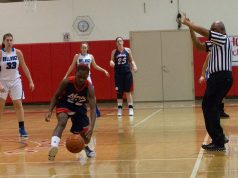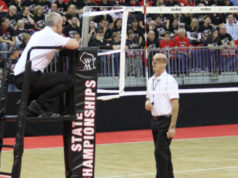The athletic spin move is often one that players, coaches and fans love to see during a game and also one that makes officials somewhat dizzy. Do you call traveling for the pivot foot touching the floor twice or let it go because most everyone in the gym won’t say a word anyway and only applaud the effort? If you do call it, be ready to explain why and which pivot foot touched the floor twice. It’s a conundrum that officials often face, especially at the higher levels.
A spin move is often used by perimeter players to create separation en route to the basket. Here’s an easy way to identify if a spin move is also a traveling violation because of the pivot foot touching the floor twice.
Contrary to identifying the pivot foot of the player in control of the ball who is making a move to spin past a defender, watch which direction the ballhandler is moving to get around that opponent. If the ballhandler, while facing the basket, spins past the defender to the ballhandler’s right, he or she is pivoting off his or her right foot and, in the majority of cases, bringing the right foot down again to help regain his or her balance after using the left foot to advance toward the basket. If the ballhandler, while facing the basket, spins to his or her left to get around an opponent, he or she will be pivoting off the left foot and likely bring that same foot down to the floor again after using the right foot to get closer to the basket.
Many will argue that it’s nearly impossible to make that move without traveling. If you identify a spin move and see the pivot come down to the floor, it is a traveling violation. If the “swing foot” doesn’t come down, it’s not a traveling violation. Many cases in which a spin move is not a traveling violation occurs when a post player, with his or her back to the basket, makes a move close to the basket and doesn’t bring the swing foot back to the ground.
Don’t rule a spin move as a traveling violation unless you’re positive. In the meantime, watch video of spin moves, especially in slow motion, to better determine and to gain confidence in identifying if it is indeed a traveling violation.
What's Your Call? Leave a Comment:
Note: This article is archival in nature. Rules, interpretations, mechanics, philosophies and other information may or may not be correct for the current year.
This article is the copyright of ©Referee Enterprises, Inc., and may not be republished in whole or in part online, in print or in any capacity without expressed written permission from Referee. The article is made available for educational use by individuals.
















